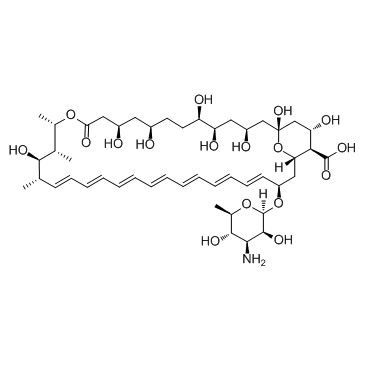Amphotericin B

Amphotericin B structure
|
Common Name | Amphotericin B | ||
|---|---|---|---|---|
| CAS Number | 1397-89-3 | Molecular Weight | 924.079 | |
| Density | 1.3±0.1 g/cm3 | Boiling Point | 1140.4±65.0 °C at 760 mmHg | |
| Molecular Formula | C47H73NO17 | Melting Point | >170°C | |
| MSDS | Chinese USA | Flash Point | 643.5±34.3 °C | |
| Symbol |

GHS07 |
Signal Word | Warning | |
|
The influence of surface charge and photo-reactivity on skin-permeation enhancer property of nano-TiO₂ in ex vivo pig skin model under indoor light.
Int. J. Pharm. 467(1-2) , 90-9, (2014) Several topical products contain nanometric TiO2 (nano-TiO2), which is a useful and safe component that absorbs UV light and does not cross skin barrier. However, nano-TiO2 may impregnate the first layer of the skin (stratum corneum, SC) and generate free rad... |
|
|
The use of chitosan-dextran gel shows anti-inflammatory, antibiofilm, and antiproliferative properties in fibroblast cell culture.
Am. J. Rhinol. Allergy 28(5) , 361-5, (2014) Chitosan-dextran gel has been used as an antihemostatic agent and antiadhesive agent after endoscopic sinus surgery. Because Staphylococcus aureus biofilms have been implicated in recalcitrant chronic rhinosinusitis, this study aimed to further investigate th... |
|
|
Flow perfusion co-culture of human mesenchymal stem cells and endothelial cells on biodegradable polymer scaffolds.
Ann. Biomed. Eng. 42(7) , 1381-90, (2014) In this study, we investigated the effect of flow perfusion culture on the mineralization of co-cultures of human umbilical vein endothelial cells (HUVECs) and human mesenchymal stem cells (hMSCs). Osteogenically precultured hMSCs were seeded onto electrospun... |
|
|
Isothiocyanate analogs targeting CD44 receptor as an effective strategy against colon cancer.
Med. Chem. Res. 23(8) , 3836-3851, (2014) Inflammatory pathway plays an important role in tumor cell progression of colorectal cancers. Although colon cancer is considered as one of the leading causes of death worldwide, very few drugs are available for its effective treatment. Many studies have exam... |
|
|
Autophagic dysregulation in glaucomatous trabecular meshwork cells.
Biochim. Biophys. Acta 1852(3) , 379-85, (2015) Primary open angle glaucoma (POAG) is a degenerative disease commonly associated with aging and elevated intraocular pressure (IOP). Higher resistance to aqueous humor (AH) outflow through the trabecular meshwork (TM) generates the elevated IOP in POAG; unfor... |
|
|
Potential role of hCG in apoptosis of human luteinized granulosa cells.
J. Reprod. Dev. 61(1) , 67-73, (2015) The corpus luteum (CL) forms after ovulation and acts as a temporary endocrine gland that produces progesterone (P4), a hormone that is essential for implantation and maintenance of pregnancy in mammals. In pregnant women, human chorionic gonadotropin (hCG) s... |
|
|
Coffee silverskin: a possible valuable cosmetic ingredient.
Pharm. Biol. 53(3) , 386-94, (2015) Currently, there is a great tendency in cosmetic area to use natural extracts. Coffee silverskin (CS) is the most abundant solid by-product generated during roasting of coffee processing.To evaluate different CS extracts as promising cosmetic ingredients, reg... |
|
|
Phospholipid scramblase 1 (PLSCR1) in villous trophoblast of the human placenta.
Histochem. Cell Biol. 143(4) , 381-96, (2015) A crucial factor for effective villous trophoblast fusion in the human placenta is the transient deregulation of plasma membrane phospholipid asymmetry leading to externalization of phosphatidylserine to the outer membrane leaflet. Screening of scramblase fam... |
|
|
Microarray-based detection of Salmonella enterica serovar Enteritidis genes involved in chicken reproductive tract colonization.
Appl. Environ. Microbiol. 80(24) , 7710-6, (2014) Salmonella enterica serovar Enteritidis has developed the potential to contaminate table eggs internally, by colonization of the chicken reproductive tract and internalization in the forming egg. The serotype Enteritidis has developed mechanisms to colonize t... |
|
|
Soluble endoglin antagonizes Met signaling in spindle carcinoma cells.
Carcinogenesis 36(2) , 212-22, (2015) Increased levels of soluble endoglin (Sol-Eng) correlate with poor outcome in human cancer. We have previously shown that shedding of membrane endoglin, and concomitant release of Sol-Eng is a late event in chemical mouse skin carcinogenesis associated with t... |